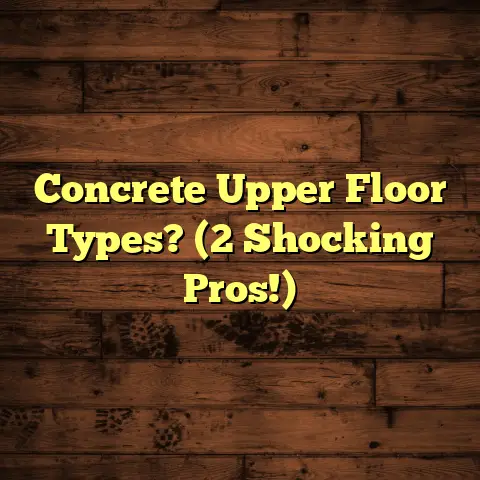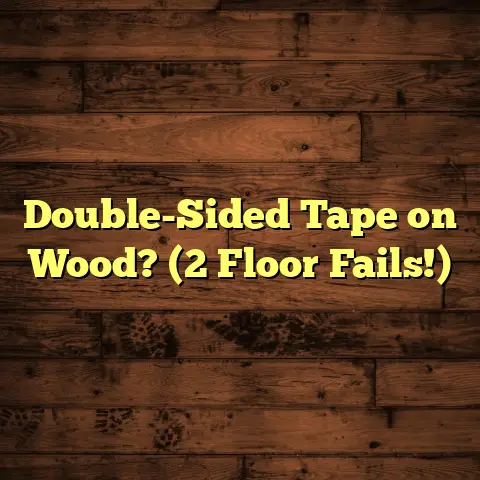Self Leveler Over Tile? (3 Subfloor Sins!)
Have you ever dreamed of transforming
that tired, uneven tile floor into a
sleek, smooth surface?
A surface that
not only looks fantastic but also enhances
the beauty and functionality of your home?
I get it.
I’ve been there, helping
homeowners and DIY enthusiasts just
like you achieve that perfect floor.
But
let me tell you, it’s not always as
straightforward as it seems.
Applying a self-leveling compound over existing tile can be a game-changer, but only if you avoid what I call the “3 Subfloor Sins.” Trust me, I’ve seen these sins derail countless projects, leading to frustration and wasted money.
Let’s dive into the world of self-leveling compounds and how to get it right.
1. Understanding Self-Leveling Compound
So, what exactly is self-leveling
compound?
Simply put, it’s a cementitious
mixture designed to flow easily and create
a smooth, level surface.
Think of it as
liquid concrete that finds its own level.
Why use it, especially over tile?
Well, imagine you’re planning to install
new flooring – maybe luxury vinyl plank
(LVP) or even a fresh layer of tile – over
an existing tile floor.
If that existing
tile has any imperfections, like uneven
tiles, cracks, or even just a slightly
sloping surface, your new floor will
inherit those imperfections.
Self-leveler bridges the gap, filling in
the low spots and creating a pristine
canvas for your new flooring.
It’s also
fantastic for encapsulating radiant floor
heating systems.
When is it beneficial?
-
Uneven Tile: As mentioned, it’s perfect for smoothing out existing tile floors.
-
Radiant Heat: It creates a smooth, even surface over radiant floor heating cables or mats.
-
Transitioning Floors: It can help to create a seamless transition between floors of different heights.
-
Preparing for New Flooring: It’s an ideal base for LVP, laminate, tile, and other types of flooring.
But here’s where those “Subfloor Sins” come
into play.
You can’t just pour self-leveler
over any old surface and expect a miracle.
You need to respect the process and avoid
these critical errors.
2. The Three Subfloor Sins
Subfloor Sin #1: Uneven Surface
This might seem obvious, but it’s often
overlooked.
I’m not just talking about
major dips and humps, but even slight
variations in the tile surface can cause
problems.
What causes an uneven tile surface?
-
Poor Installation: The original tile job might have been flawed, with inconsistent mortar application.
-
Settling: Over time, the subfloor can settle unevenly, causing tiles to shift.
-
Damage: Cracks, chips, or loose tiles can create an uneven surface.
-
Expansion/Contraction: Temperature and humidity changes can cause tiles to expand and contract, leading to movement and unevenness.
Consequences of ignoring this sin?
-
Improper Adhesion: The self-leveler might not bond properly to the high points of the tile.
-
Cracking: The self-leveler can crack over time if it’s not supported properly.
-
Uneven Finished Floor: You might end up with a finished floor that still has subtle imperfections.
-
Wasted Material: You’ll use more self-leveler than necessary, costing you money.
I remember one job where the homeowner
insisted the tile was “pretty level.” I
used my trusty 6-foot level and found
variations of up to 1/4 inch in some areas!
Ignoring that would have been a disaster.
Subfloor Sin #2: Improper Adhesion
Self-leveler needs to bond to the
existing tile.
It’s not just about
filling in the gaps; it’s about creating
a solid, unified surface.
Factors affecting adhesion:
-
Surface Contaminants: Dirt, grease, wax, and old adhesives can prevent the self-leveler from bonding.
-
Moisture: Excess moisture in the tile or subfloor can weaken the bond.
-
Tile Condition: Cracked, loose, or crumbling tiles won’t provide a stable base.
-
Tile Type: Some tile types, like glazed porcelain, are inherently less porous and require special preparation.
Testing for adhesion:
Before you even think about pouring self-leveler, do this simple test:
-
Clean a small area of the tile.
-
Apply a small amount of self-leveler.
-
Let it cure according to the manufacturer’s instructions.
-
Try to chip it off with a chisel or scraper.
If it comes off easily, you have an adhesion problem.
Preparing for better adhesion:
Cleaning: Thoroughly clean the tile with a degreasing cleaner.
I recommend a product like TSP (trisodium phosphate) substitute, followed by a rinse with clean water.Scarifying: For glazed tiles, you might need to scarify the surface to create a better bond.
This can be done with a diamond grinding pad or a shot blaster.Priming: Apply a primer specifically designed for use with self-leveling compounds.
This will help to improve adhesion and prevent pinholing.
I always tell my clients, “Think of it like
painting a car.
You wouldn’t just slap paint
on a dirty, rusty surface, would you?” Same
principle applies here.
Subfloor Sin #3: Insufficient Preparation
This is the umbrella sin that encompasses
everything else.
It’s about taking the
time to do the job right, from start to
finish.
Critical preparation steps:
-
Cleaning: As mentioned earlier, this is crucial.
Repairing Damage: Fix any cracks, chips, or loose tiles.
Use a high-quality tile adhesive or epoxy filler.-
Leveling Minor Imperfections: Use a patching compound to fill in small gaps or depressions.
Creating a Dam: If you’re working in a large area, you might need to create a dam to contain the self-leveler.
This can be done with foam strips or wood.-
Ventilation: Ensure proper ventilation to allow the self-leveler to dry properly.
Tools and materials you’ll need:
-
Cleaning Supplies: Degreaser, scrub brush, rags, bucket.
-
Repair Materials: Tile adhesive, epoxy filler, patching compound.
-
Leveling Tools: Level, straightedge, measuring tape.
-
Mixing Equipment: Mixing bucket, drill with mixing paddle.
-
Application Tools: Spiked roller, gauge rake, smoothing trowel.
-
Safety Gear: Gloves, eye protection, dust mask.
I’ve seen contractors skip steps to save
time, and it always comes back to bite them.
Proper preparation is the foundation of a
successful self-leveling project.
3. The Application Process
Okay, you’ve avoided the sins. Now, let’s talk about the actual application.
Step-by-step guide:
Read the Instructions: This might seem obvious, but I can’t stress it enough.
Each self-leveling compound is different, so follow the manufacturer’s instructions carefully.Mix the Compound: Use a drill with a mixing paddle to mix the self-leveler according to the instructions.
Add the powder to the water gradually, and mix until you have a smooth, lump-free consistency.Pour the Compound: Pour the self-leveler onto the prepared tile surface.
Start in the deepest area and work your way outwards.Spread the Compound: Use a gauge rake to spread the self-leveler evenly.
The gauge rake will help you to control the thickness of the application.-
Use a Spiked Roller: Immediately after spreading the self-leveler, use a spiked roller to remove any air bubbles.
Allow to Cure: Allow the self-leveler to cure according to the manufacturer’s instructions.
This can take anywhere from 24 to 72 hours, depending on the product and the ambient temperature.
Tips for a smooth finish:
-
Work in Sections: If you’re working in a large area, divide it into smaller sections and work on each section separately.
-
Monitor the Curing Process: Check the self-leveler regularly during the curing process to make sure it’s drying evenly.
-
Protect the Surface: Protect the newly leveled surface from dust, debris, and foot traffic until it’s fully cured.
I like to use a laser level to ensure I’m
achieving a perfectly level surface.
It’s
an investment, but it pays off in the long run.
4. Common Mistakes to Avoid
Let’s recap some common pitfalls:
Not Cleaning the Surface Properly: I can’t stress this enough.
A clean surface is essential for proper adhesion.-
Using the Wrong Primer: Use a primer that is specifically designed for use with self-leveling compounds.
Mixing the Compound Incorrectly: Follow the manufacturer’s instructions carefully.
Too much water or not enough mixing can weaken the self-leveler.-
Pouring Too Much Compound at Once: This can cause the self-leveler to overflow and create a mess.
-
Not Using a Spiked Roller: This can lead to air bubbles, which can weaken the self-leveler.
-
Walking on the Surface Too Soon: Allow the self-leveler to cure completely before walking on it.
-
Not Protecting the Surface During Curing: Protect the newly leveled surface from dust, debris, and foot traffic.
Alternatives to Self-Leveler:
While self-leveler is often the best solution, there are alternatives in certain situations:
-
Patching Compound: For small imperfections, a patching compound might be sufficient.
-
Underlayment: A thick underlayment can help to smooth out minor imperfections.
-
Grinding: Grinding down high spots in the tile can sometimes be an option.
I generally recommend self-leveler for anything
more than minor imperfections.
It provides the
most reliable and long-lasting solution.
5. Conclusion
So, there you have it – the secrets to
successfully applying self-leveling compound
over tile.
Remember those “3 Subfloor Sins”:
- Uneven Surface
- Improper Adhesion
- Insufficient Preparation
Avoid them like the plague, and you’ll be well on your way to achieving that dream of a beautiful, level floor.
It’s a process that demands attention to
detail, but the reward is a flawless
foundation for your new flooring, and a
home that reflects your vision.
Don’t
cut corners, take your time, and enjoy
the satisfaction of a job well done.
You
got this!





